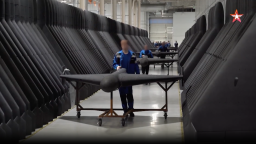Health
Russia Expands Drone Production, Marginalizing Iran’s Role

Russia has significantly expanded its drone production capabilities, particularly at the Alabuga facility, which is located in the Tatarstan region, approximately 600 miles east of Moscow. The factory, which specializes in producing the Iranian-designed Shahed-136 attack drone—referred to as Geran in Russia—has transitioned much of its manufacturing processes locally. This shift has led to concerns in Tehran regarding its diminishing influence over the production of the drones that it originally supplied to Moscow.
During a recent documentary, CEO Timur Shagivaleev highlighted the advancements at Alabuga, stating, “This is a complete facility,” where most components of the Shahed-136 are now fabricated domestically. This includes everything from two-stroke engines to microelectronics, indicating a substantial integration of the drone’s production within Russia’s military industrial complex. Analysts estimate that approximately 90% of the drone’s production now occurs at Alabuga and other Russian facilities.
Recent satellite imagery confirms that Alabuga is undergoing extensive expansion, with new production lines and living quarters being developed. Experts suggest this growth positions Russia to potentially export an upgraded version of the drone, possibly even back to Iran. A Western intelligence source noted that the complete integration of the Shahed-136 into Russian production has led to a marginalization of Iranian influence, which has created a notable rift between the two countries.
The relationship between Moscow and Tehran has grown increasingly strained, particularly following Iran’s support for Russia during its ongoing conflict in Ukraine. Despite providing drones and military assets, Iran has expressed dissatisfaction with the lack of reciprocation from Russia. Political analyst Ali Akbar Dareini from the Tehran-based Center for Strategic Studies stated that Iran may have anticipated a more robust response from Russia, especially during Israel’s military actions targeting Iranian nuclear sites in June.
The shift in dynamics has raised questions about the nature of the partnership. According to a Western intelligence official, the relationship is “purely transactional and utilitarian,” emphasizing that Russia has shown little inclination to act beyond its immediate interests, even when a partner is threatened.
Production and Cost Efficiency
Following Russia’s full-scale invasion of Ukraine in February 2022, the country began importing Iranian Shahed drones. By early 2023, a $1.75 billion deal was finalized, allowing Russia to manufacture the drones domestically. The initial contract stipulated the production of 6,000 drones by September 2025, which has been substantially accelerated, with Alabuga reportedly producing over 5,500 units per month.
The efficiency gains have also led to a significant reduction in costs. In 2022, the average price paid by Russia for each drone was approximately $200,000. By 2025, this cost is expected to drop to around $70,000. Furthermore, improvements have been made to the drone’s design, including enhanced communications and larger warheads, making them more effective in combat.
While Iran initially welcomed the localization of drone production, the rapid upgrades by Russia have caught Tehran off guard. Experts suggest that this development signifies a gradual erosion of Iran’s control over the final product, which is now largely produced independently in Russia.
Challenges in the Partnership
Despite the advancements, the relationship faces significant challenges. Iranian companies, including Sahara Thunder, have reportedly experienced payment delays, attributed to the economic sanctions impacting Russia. Analysts note that these obstacles have contributed to Tehran’s frustration, particularly regarding the promised transfer of aeronautical technologies from Russia.
The ceasefire between Israel and Iran has pushed Tehran to reassess its strategies and rebuild from recent conflicts. As Iran looks to recover from the damage inflicted on its nuclear facilities, experts like David Albright, a former UN weapons inspector, believe that Russia’s expanded capabilities may allow it to provide meaningful support to Iran, potentially including updated versions of the Shahed drones.
Open-source flight tracking data has revealed that a Gelix Airlines Ilyushin-76 military cargo plane transported unknown cargo from Moscow to Tehran on July 11. While the specifics of the shipment remain unverified, Iranian media speculated it included components for a Russian S-400 air defense system.
As the relationship between Russia and Iran evolves, analysts like Dareini suggest that despite tensions, both nations ultimately stand to benefit. Iran’s access to military hardware and technological support may strengthen its security apparatus, though the future of their partnership remains uncertain as both countries navigate their respective interests.
-

 Lifestyle5 months ago
Lifestyle5 months agoLibraries Challenge Rising E-Book Costs Amid Growing Demand
-

 Sports4 months ago
Sports4 months agoTyreek Hill Responds to Tua Tagovailoa’s Comments on Team Dynamics
-

 Sports4 months ago
Sports4 months agoLiverpool Secures Agreement to Sign Young Striker Will Wright
-

 Lifestyle4 months ago
Lifestyle4 months agoSave Your Split Tomatoes: Expert Tips for Gardeners
-

 Lifestyle4 months ago
Lifestyle4 months agoPrincess Beatrice’s Daughter Athena Joins Siblings at London Parade
-

 Science4 months ago
Science4 months agoSan Francisco Hosts Unique Contest to Identify “Performative Males”
-

 World4 months ago
World4 months agoWinter Storms Lash New South Wales with Snow, Flood Risks
-

 Science5 months ago
Science5 months agoTrump Administration Moves to Repeal Key Climate Regulation
-

 Business5 months ago
Business5 months agoSoFi Technologies Shares Slip 2% Following Insider Stock Sale
-

 Science5 months ago
Science5 months agoNew Tool Reveals Link Between Horse Coat Condition and Parasites
-

 Sports5 months ago
Sports5 months agoElon Musk Sculpture Travels From Utah to Yosemite National Park
-

 Science5 months ago
Science5 months agoNew Study Confirms Humans Transported Stonehenge Bluestones









